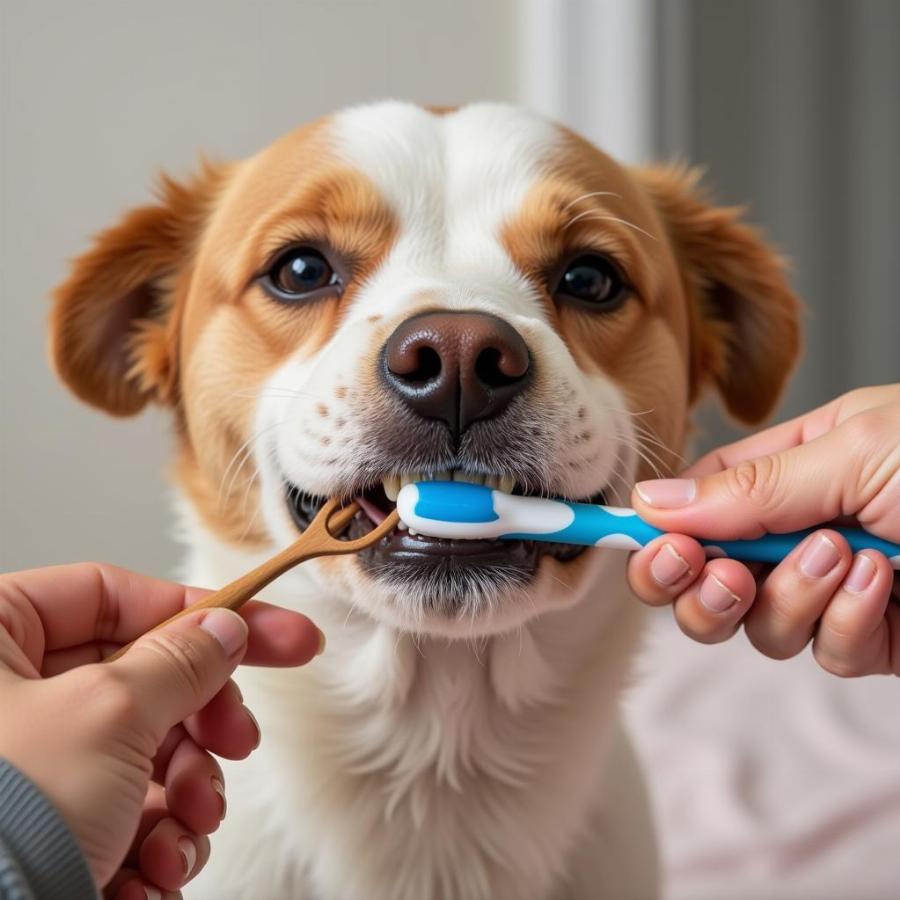Dog tartar removal is crucial for maintaining your furry friend’s oral health. Left untreated, tartar buildup can lead to gum disease, tooth loss, and even more serious health problems. This comprehensive guide will cover everything you need to know about dog tartar removal, from prevention to professional cleaning.
Understanding Dog Tartar
What exactly is dog tartar? It’s hardened plaque, a sticky film of bacteria that constantly forms on your dog’s teeth. When plaque isn’t removed through regular brushing, it mineralizes with saliva and hardens into tartar, also known as calculus. This yellowish-brown deposit is more than just unsightly; it’s a breeding ground for bacteria that can wreak havoc on your dog’s oral health.
Preventing Tartar Buildup
The best way to deal with dog tartar is to prevent it in the first place! Regular brushing is the cornerstone of good canine dental hygiene. Aim to brush your dog’s teeth daily using a dog-specific toothpaste. Never use human toothpaste, as it contains ingredients that can be harmful to dogs.
Choosing the right dog food can also make a difference. Some dry foods are specifically formulated to help scrape away plaque as your dog chews. Dental chews and toys can also provide some mechanical cleaning action.
 Brushing a Dog's Teeth
Brushing a Dog's Teeth
At-Home Dog Tartar Removal Methods
While professional cleaning is the most effective way to remove tartar, there are some things you can try at home to help manage mild buildup. Dental chews and treats can help scrape away some plaque and tartar. There are also special dental wipes and gels available. However, these methods are not a substitute for professional cleaning.
If you notice significant tartar buildup, it’s essential to take your dog to the vet. Attempting to remove hardened tartar at home can damage your dog’s teeth and gums.
Professional Dog Tartar Removal
Professional dog tartar removal is performed by a veterinarian under general anesthesia. This allows the vet to thoroughly clean all surfaces of the teeth, including areas below the gumline, without causing your dog any pain or stress. The vet will also assess your dog’s overall oral health and identify any underlying issues.
Why is Dog Tartar Removal Important?
Dog tartar removal is essential for preventing a range of dental problems. Tartar buildup can lead to gingivitis, an inflammation of the gums. If left untreated, gingivitis can progress to periodontitis, a severe infection that can damage the tissues supporting the teeth. This can ultimately result in tooth loss. Furthermore, bacteria from oral infections can enter the bloodstream and affect other organs, such as the heart, liver, and kidneys.
Signs Your Dog Needs Tartar Removal
How can you tell if your dog needs tartar removal? Some common signs include bad breath, yellow or brown buildup on the teeth, red or swollen gums, difficulty eating, and excessive drooling. If you notice any of these signs, it’s important to schedule a check-up with your veterinarian. Like do dogs get cavities, tartar buildup is a serious concern.
What to Expect After Professional Cleaning
After professional cleaning, your dog’s mouth will be much healthier. Your vet may recommend a special diet, dental chews, or other at-home care to help prevent future tartar buildup. Regular brushing is still crucial. Just like with salivary gland infection in dogs, prevention is key.
How Can I Remove Tartar From My Dog’s Teeth at Home?
While at-home solutions like dog dental wipes can help with plaque, significant tartar requires professional attention. Avoid attempting to scrape it off yourself as this could cause damage similar to issues like hard plaque on dog’s teeth.
Is Tartar Buildup Painful for Dogs?
Yes, tartar buildup can be painful. It can lead to inflamed gums, similar to hyperplasia of gums in dogs, and eventually even cause loose or lost teeth.
Conclusion
Dog tartar removal is an important part of maintaining your dog’s overall health. By understanding the causes, prevention methods, and treatment options for tartar buildup, you can help keep your furry friend’s smile healthy and bright. Remember, regular veterinary check-ups and professional cleanings are key to preventing serious dental problems.
FAQ
- How often should I brush my dog’s teeth? Ideally, daily.
- What type of toothpaste should I use? Always use a dog-specific toothpaste.
- Can I use human toothpaste on my dog? No, human toothpaste can be harmful to dogs.
- What are signs my dog needs professional cleaning? Bad breath, visible tartar, red gums, difficulty eating.
- Is anesthesia required for professional cleaning? Yes, for thorough and pain-free cleaning.
- How can I prevent tartar buildup? Regular brushing, dental chews, and specialized diets.
- What happens if tartar is left untreated? Gum disease, tooth loss, and potential systemic health issues.
Further Reading:
Do you have other questions about your dog’s dental health? You might find these related articles helpful:
- Do dogs get cavities?
- Salivary gland infection in dogs
- Dog dental wipes
- Hard plaque on dog’s teeth
- Hyperplasia of gums in dogs
Beaut Dogs is your one-stop resource for all things canine, offering reliable and comprehensive information on dog breeds, care, and health. For personalized advice and further assistance, reach out to us at [email protected]. We’re here to help you navigate the wonderful world of dog ownership! Visit us at Beaut Dogs for more expert advice and guidance.